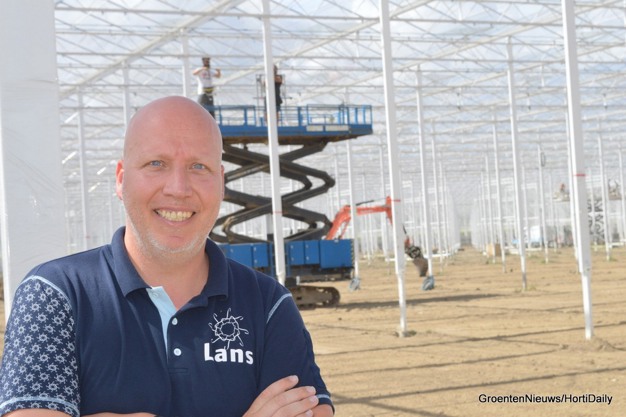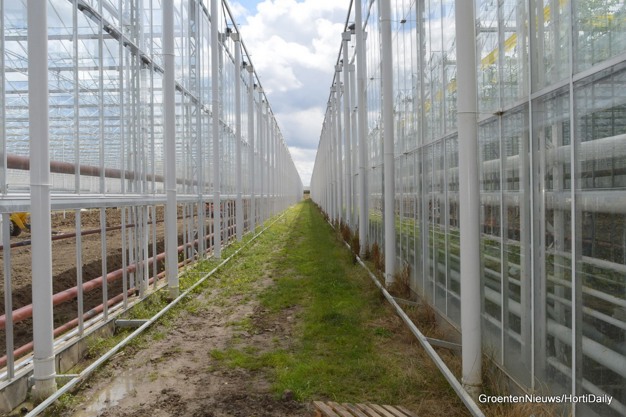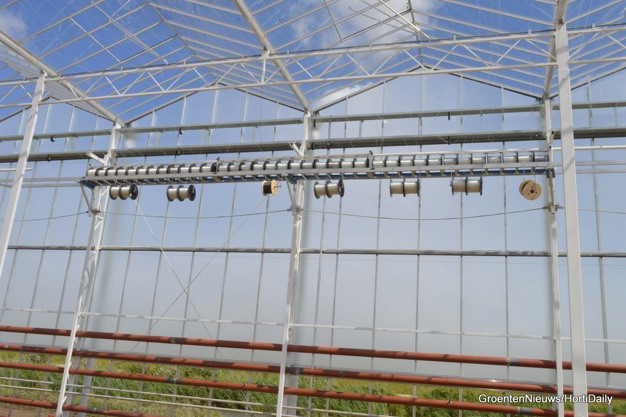The land purchased by Lans in Dinteloord, Netherlands, is being developed in phases. Kubo is now constructing phase 2, which, like phase 1, will span eight hectares. In Dinteloord, there are still ample opportunities for expansion, with about 18.5 hectares remaining available for development.
However, Lans is cautiously exploring expansion opportunities beyond the Netherlands. It seems their one location in Egypt will not be their last. Ewin van der Lans, Chief Operating Officer of Lans, cites scaling up as essential to meet customer demand. Customers are requesting tomatoes from almost every segment, and Lans is eagerly addressing this demand. Scaling up also means a lesser increase in cost price. With the future of tomato supply solely from the Netherlands looking less certain, they are also setting their sights on locations abroad.

Erwin van der Lans during our visit to the new construction site
Labor and energy costs are the main drivers of cost increases. Therefore, Lans is closely monitoring developments in robotics, among other things. For now, they are focusing on labor-saving mechanization. The new AGVs (harvesting carts) from Bogaerts Greenhouse Logistics are a prime example. These AGVs will be used in the new greenhouse, making work easier by eliminating the need to push carts manually.

Tie wrapping is automated. It saves half the time. View the full photo impression of the construction activities for Lans in Dinteloord here.
Sustainability
Sustainability often comes at a high cost, but Lans sees the necessity of sustainable tomato production. They have invested in full-LED lighting (Food Autonomy) for phase 2.
Erwin says, "With the current energy prices, this purchase can be justified. If that changes, we may need to adjust our cultivation practices, such as reducing lighting. It would be unfortunate, as we are more than ready for a great tomato production, but it may be necessary. We'll see."
The energy issue is certainly on Lans' mind. With their move to Dinteloord, they were looking forward to the residual heat and CO₂ from the PreZero waste-to-energy plant in Roosendaal. But that has not yet come to fruition.
Erwin sees a future in such initiatives. "These types of facilities will help the Netherlands continue to provide for its food supply. The same goes for geothermal energy, which also helps keep energy costs manageable."
Open Questions
The new greenhouse in Dinteloord is a conventional greenhouse equipped with basic techniques, LED lighting, and two screens from Ludvig Svensson. Lans is waiting for the day when there are solutions for combining heat, CO₂, moisture removal, and electricity.
Erwin explains, "To save heat, we naturally want to keep the windows closed as much as possible. That's not always feasible, as it creates a problem with moisture removal. And as for electricity, there's currently enough power on the grid for phases 1 and 2, but not yet for phases 3 and 4. We hope this will be resolved soon. We want to move forward."
Finding solutions to these challenges will help Lans work with their mission in mind. That mission is to cultivate as intensively as possible, aiming for maximum yields per hectare while keeping the hortifootprint as low as possible, both in the Netherlands and abroad.
Erwin states, "We want to 'race in Formula 1' or 'play in the Champions League,' to use a football analogy. We aim to be among the top in the Netherlands. That's why we need to be future-proof. And if that means growing tomatoes abroad, we'll do so gladly."
 Left under construction (phase 2) and right is phase 1. View the full photo impression of the construction activities for Lans in Dinteloord here.
Left under construction (phase 2) and right is phase 1. View the full photo impression of the construction activities for Lans in Dinteloord here.
New Construction
Currently, work is progressing rapidly. Kubo is almost finished with a few minor details remaining. This makes room for the screen installer (A1 Horticultural Technology), heating installer (Voshol), subterranean water technology (Stolze), lighting and associated cabling (Gebr. Geers), gutter supplier (Meteor Systems), and the installation of the Hoogendoorn climate computer (Stolze). The medium-voltage supplier is Anexo.
A few Lans employees are installing the prefab cabling, crop wires, pipe rail supports (Metazet), and laying the ground cover themselves.

The pulleys are ready to pull the wire beds. View the full photo impression of the construction activities for Lans in Dinteloord here.
Wet
Coordinating so many parties is quite the puzzle, requiring time and space for everyone. With the construction of phase 1, a lot of preparatory work was done to allow phases 2, 3, and 4 to connect efficiently. Nevertheless, construction supervision is necessary and useful.
The schedule is going well despite some setbacks. Heavy rain disrupted the start of the steel construction. Erwin says, "Usually, it's dry after April 1st. This year, it was the opposite. Then it really started to rain. We couldn't continue, which put us a week behind schedule. We must and will catch up. Such greenhouses need to be built in about seven months. There's not much leeway. We know that."
The ship carrying the glass also had to detour via South Africa, causing further delays. Erwin notes, "Fortunately, an extra glazing crew was deployed. That helps."
In week 44, the plants will be put in. Phases 1 and 2 in Dinteloord will be filled with tomatoes for the large cluster segment: Macxize.
View the photo galery of the construction here.
For more information:
Erwin van der Lans
Lans
+31 6 28 90 33 10
[email protected]
www.lans.nl
Kubo
+31 174 286 161
[email protected]
www.kubogroup.nl
